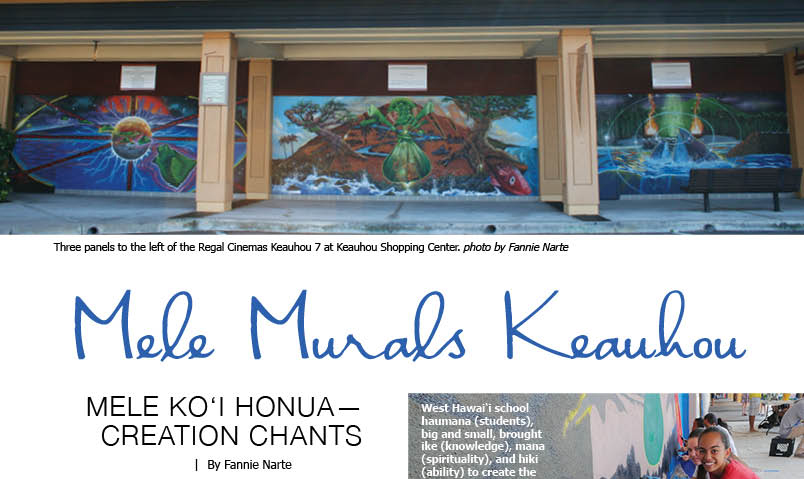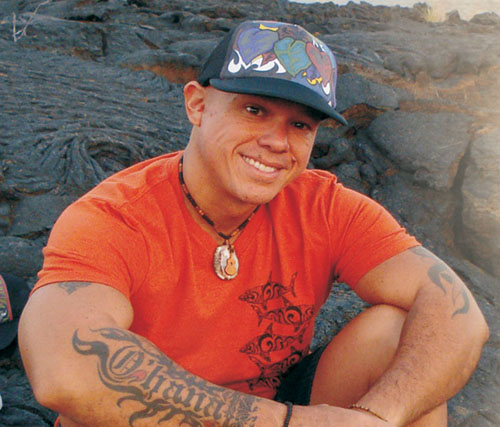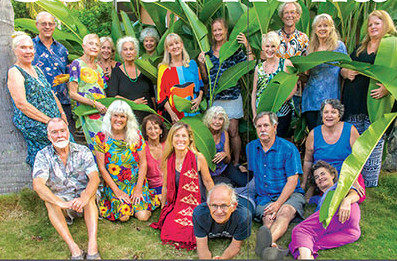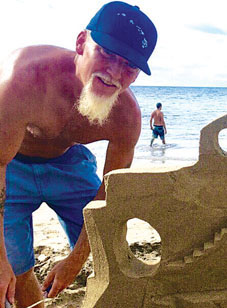
Mele Murals Keauhou, Mele Ko‘i Honua—Creation Chants

By Fannie Narte
Mele Murals is about sharing Hawai‘i’s stories—Our Stories—through art and narrative. These colorful murals command attention and have an enormous historical and cultural impact that will move our people forward as a community.
The Estria Foundation (TEF) and the Mele Murals team, comprised of many local teachers, business and community leaders, cultural practitioners, artists, and students joined forces to produce another set of beautiful murals. The Mele Murals located at the Keauhou Shopping Center on the outside walls of the Regal Keauhou Stadium 7 Movie Theater have a total of seven panels.
The three panels to the left of the movie theater entrance are featured in this second article in our Mele Murals series. The remaining four panels will be featured in an upcoming issue.
‘Ōpio (youth) from Ke Kula o ‘Ehunuikaimalino (KKOE) (lead school), Konawaena High School, Pūnana Leo o Kona, Innovations Public Charter Schools, Kanu o ka ‘Āina, and Kamehameha Schools Pre-School participated in this project.
The ‘ōpio, under the guidance of Kumu ‘Ilikea Kam from KKOE, (lead kumu) and Kumu Kanoa Castro of Ho‘ala Arts, the Mele Murals club from Kanu o ka ‘Āina, and the team of cultural practitioners and resources, explore the meaning and kaona (hidden meaning) of the mele’s lyrics in the context of past and present community issues in their workshops. The result of this exploration provides the content that informs their murals.
The mele (song, chant) part of Mele Murals is inspired by Hawaiian music and chant. It celebrates and honors connection to the ‘āina (land), chronicles traditions and mo‘olelo (stories), and binds Hawai‘i’s people together with the past and the future.
The three panels featured in this article are inspired by “Mele Ko‘i Honua,” or creation chants.
Mele Ko‘ i Honua
Wākea lived with Papa, begetter of islands
Begotten was Hawai‘i, an island
Begotten was Maui, an island
Wākea made a new departure and lived with Ho‘ohokukalani
Begotten was Moloka‘i, an island
Begotten was Lana‘i, an island
The womb of Papa became jealous at its
partnership with Ho‘ohokukalani
Papa returned and lived with Wākea
Begotten was O‘ahu, an island
Begotten was Kaua‘i, an island
Begotten was Ni‘ihau, an island
A red rock was Kaho‘olawe
The panels represent three main sources of Hawaiian ‘ike (knowledge). They are Papahulilani (the realm of the heavens), Papahānaumoku (the realm of creation), and Papahulihonua (the realm of the earth and the ocean), which are from the Kumulipo, ancient creation chant.
The combination of these three sources of ‘ike is “Papakū Makawalu.” Papakū (foundation) Makawalu (literally “eight eyes”) is a multifaceted phrase used to express the Hawaiian worldview of the physical, intellectual, and spiritual foundations from which life cycles emerge.
The Edith Kanaka‘ole Foundation states that Papakū Makawalu “is a methodical presentation of a holistic preview of the Hawaiian universe. It is an abstract from Wā ‘Umikūmākolu (Section 13) of the Kumulipo. Wā ‘Umikūmākolu begins with Palikū and Paliha‘a, the male and female ancestors of Haumea. Haumea is the ancestor credited for the pedagogy of categorizing and organizing the natural world.”
“Papakū Makawalu is the ability of our kūpuna (elders) to categorize and organize our natural world and all systems of existence within the universe. It is the foundation to understanding, knowing, acknowledging, becoming involved with, and most importantly, becoming experts of the systems of this natural world.”
Papakū Makawalu
The Edith Kanaka‘ole Foundation provides the following description of the three houses of knowledge:
Papahulilani
Papahulilani is the house of knowledge that studies all atmospheric cycles. It is the space from above the head to where the stars sit. It is inclusive of the sun, moon, stars, planets, winds, clouds, and the measurement of the vertical and horizontal spaces of the atmosphere. It is also a class of experts who are spiritually, physically, and intellectually attuned to the space above and its relationship to the earth.
Papahānaumoku
Papahānaumoku is the house of knowledge that studies all living organisms. It is the birthing cycle of all flora and fauna inclusive of man. It is the process of investigating, questioning, analyzing, and reflecting upon all things that give birth, regenerate, and procreate. It is also a class of experts who are spiritually, physically, and intellectually attuned to things born and the habitat that provides their nourishment, shelter, and growth.
Papahulihonua
Papahulihonua is the house of knowledge that studies all earth cycles. It is inclusive of earth and ocean. It is the ongoing study of the natural earth and ocean and its development, transformation, and evolution by natural causes. It is also a class of experts who are spiritually, physically, and intellectually attuned to this earth and its relationship to the space above and the life forms on it.
The Mele Murals project is a success because of the many people who are involved. Lily Dudoit and Nani Kupihe shared the stories of Kaukulaelae and ‘Anakala Mahealani Pai, ‘Anake Kalani Kahulamu, and Malia Kipapa shared the mo‘olelo of Kahalu‘u with the youth. The staff at the Sheraton Kona Resort & Spa at Keauhou Bay and ‘Anakala Tava Taupu also helped our participating youth learn the stories in the panels.
After much study, research and exploration, the youth transfer their vision to the walls with the help of lead artist, John “Prime” Hina III, Founder and Director of 808 Urban, a Hawaiian nonprofit arts organization, and Estria Miyashiro, Founder and Creative Director of The Estria Foundation and the Mele Murals project. Local kōkua (volunteer) artists Miho Morinoue, Lindsay Lander, Kawika Duncan and Kathleen Abood were a part of this creative team.
Description of the Three Mele Murals
Kumu ‘Ilikea provided the following descriptions of the three panels, which includes comments by the participating ‘ōpio.
Papahulilani
This panel depicts the eight Hawaiian Islands in the heavenly realm. The kaona is that the eight Hawaiian Islands also represent the eight planets of our universe. Malie Sarsona, a student from Kanu o ka ‘Āina, said that the wall “made me think of makawalu as more than seeing through different perspectives, but to see through the eyes of Kaho‘olawe, Hawai‘i, Saturn, Neptune, and even Mars.”
The compass is a tribute to the courage of our Polynesian ancestors who navigated distant voyages using the stars to guide them. Kumu ‘Ilikea says, “The sun represents kanaka (mankind) in relationship to our universe.”
The painting is divided into eight spaces, which represent the concept of makawalu, or looking at everything from a different perspective “of eight eyes” in which layers of knowledge are uncovered.
The “eye of Laniakea” is also present on this panel and can be seen at a distance. Laniakea (immeasurable heaven) is the name of a supercluster of galaxies, which includes our galaxy, the Milky Way.
Nainoa Alefaio, a student from KKOE, added that the “eye symbolizes our ancestors watching over us, and the red lines coming out of the center represents the Hawaiian blood lines.”
Papahānaumoku
Kumu ‘Ilikea says, “Papa Hānau Moku is described as the life-giving realm, which is depicted in this panel as envisioned by the students of KKOE.” “Papahānaumoku,” says Nainoa, “is anything that is living.”
Hualālai stands tall in the background of this panel as the foundation and main water source of Keauhou. The hands in the foreground are facing downward to show that we are stewards of the land. Nainoa says that the two hands represent humans working on the ‘āina.
“Huli ka lima i lalo is one of the many ‘ōlelo no‘eau (wise proverb) told to us by our kūpuna,” says Malie. “They repeated over and over, ‘Turn your hands down to the honua. When your hands are up, you are begging for things to be given to you. Don’t be lazy.’”
The ho‘okupu (ceremonial gift) is symbolic of giving back. The fetus within the ho‘okupu represents new life and new beginnings, with a hāpu‘u fern shoot as the piko (center).
The gnarly trees shown at the base of the mountain are known as the “Menehune trees” of Kaukulaelae. The bumps on these trees are likened to the muscles of the Menehune, miniature legendary beings of strength and wisdom. Nainoa says that he saw those trees on the grounds of the Sheraton Kona Resort & Spa at Keauhou Bay. “I thought the trees were really cool and represent Papahānaumoku because she is a living reproducing organism.”
The kūmū or red fish represents Kanikanika‘ula, the fishing heiau at Kaukulaelae at Keauhou Bay.
Papahulihonua
At the center of this panel is the Hāpaiali‘i Heiau of Kahalu‘u. Hāpai means to elevate and ali‘i means chief or chiefess. When combined, Hāpaiali‘i means to elevate the chiefs or chiefess’. The Hāpaiali‘i Heiau served as a birthing place for those of ali‘i lineage.
During the restoration of Hāpaiali‘i, two sets of measurements were found. It was the significance of Hāpaiali‘i during the winter and summer solstices that helped confirm the location of the traditional perimeter lines. Carbon dating was used to determine the age of Hāpaiali‘i, as well as indicate that there was a fire source on the heiau. Research also revealed that this heiau had its own water source. This heiau was likely used as a lighthouse for wa‘a (canoes) returning to Kahalu‘u at night.
Ke‘eku is the heiau standing off to the right side, which has walls of 30-degree angles. Wherever the ali‘i are present, there you will find niu (coconut) trees. Kahalu‘u once flourished with niu. The niu is symbolic in Hawaiian culture. The coconut trees are known as one of the first navigators, having fallen from above, they would travel the ocean and find their way elsewhere. Coconut water is prized as being pure and untouched. This served as yet another water source to the already plentiful area of Kahalu‘u.
The two whales, or koholā, are depicted here as offering reverence to this heiau.
The three circular shapes represent our three piko, symbolizing the past, to honor those who came before us; the present, to signify us and those who are a part of us; and the future, looking to what we can see in the times to come.
In addition, Nainoa says that the three circles represent the songs the whales sing. He says, “We painted the whales coming out of the water because they are reaching out to the ancestors.”
“ Our work honors the last commands of King David Kalākaua,
‘ Look to the keiki, teach them, groom them, show them wonder, and inspire them.’”-Mele Murals, The Estria Foundation
The Mele Murals project is dedicated to creating social change by empowering local communities through the creation of art. TEF requires engagement from stakeholders and a sense of ownership among the people who live in the communities where their projects are located. This requirement calls everyone in the community to come forward and kōkua or help, and that’s what happened.
In addition to the many participants in this project, the hard work and dedication of the staff at KKOE, Kumu Steve Gardner, Mele Murals club advisor at KKOE, and the team of supportive parents were instrumental to its success. The generosity and support from Kamehameha Schools, The Bill Healy Foundation, and Kristin Kamakau of Colliers International were tremendous. Support from local businesses such as Longs Drugs, Subway, KTA, L&L Hawaiian Barbecue, and Peaberry & Galette were also important to the success of this project.
After many months of planning and work, members of the community and the team of participants gathered to celebrate the mural’s completion at its unveiling in November of 2014. At that time, participating ‘ōpio were invited to share their mana‘o (belief). They stepped forward, one at a time, telling the stories of the murals in their own words. They became Storytellers.
They stood tall and shared their experiences with confidence. They became Leaders.
These murals now stand as monuments, holding our precious stories until they are rediscovered and the stories are retold again and again. Each time Our Stories are retold, our people move forward as a community, and as a nation. ❖
Contact The Estria Foundation and Mele Murals
Contact the Edith Kanakaole Foundation
Contact the writer


